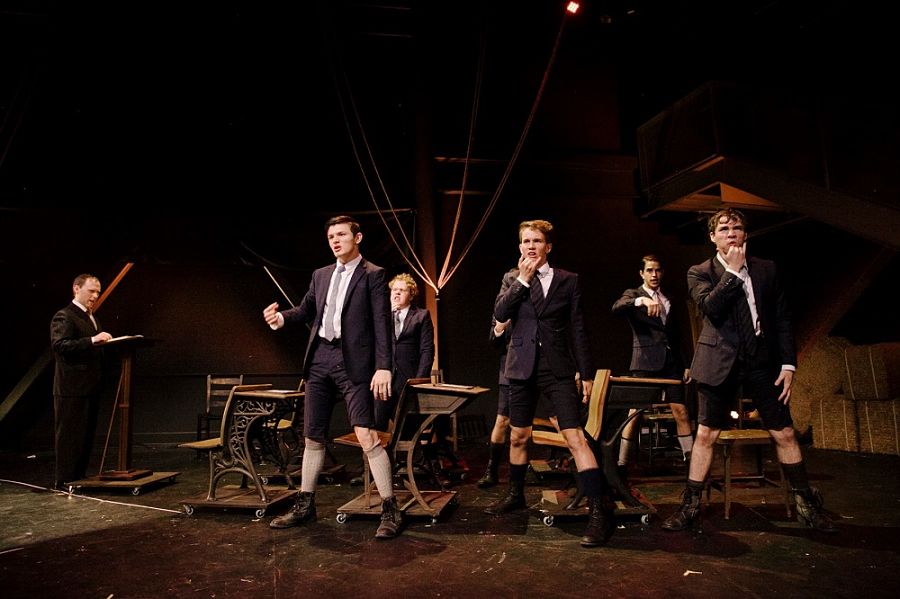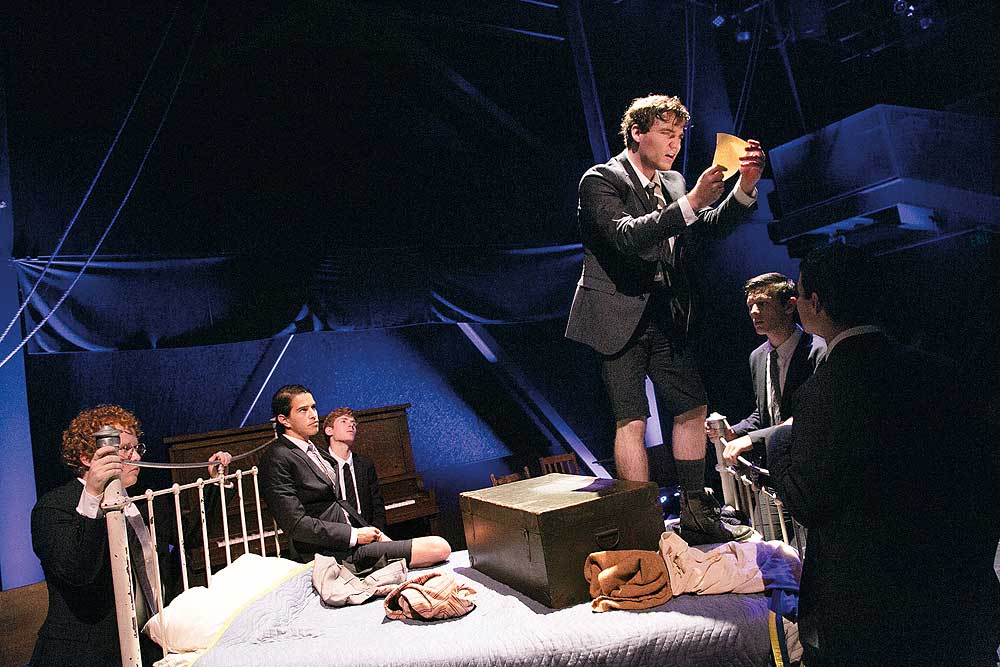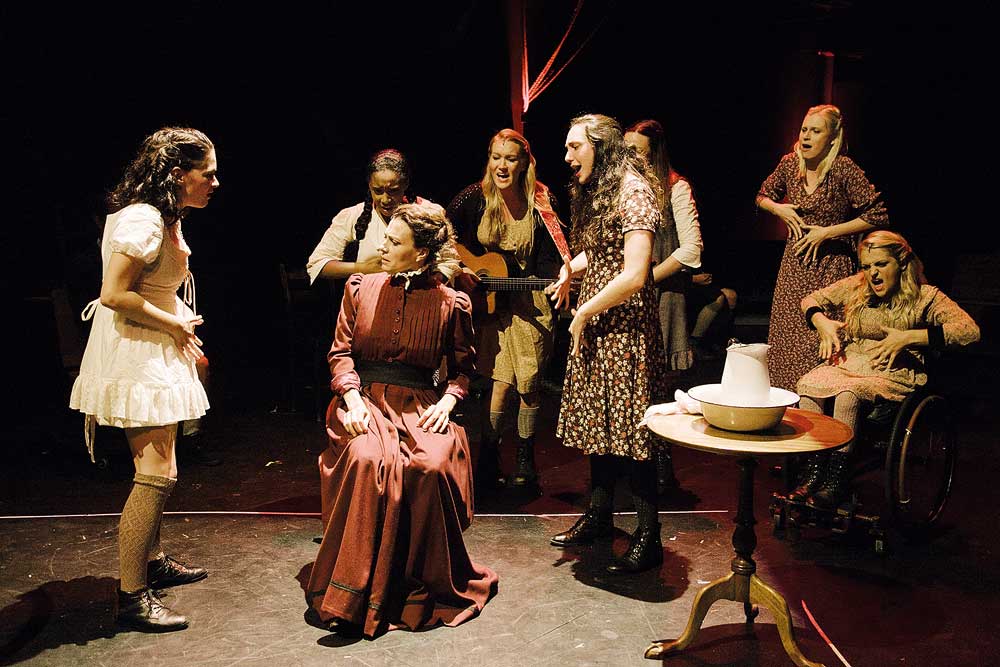“To me, the play speaks to those who are denied a voice, to those who don’t fit into the norm, to those who are questioning and experiencing the pains of growing up.” That’s a key sentence from Michael Arden’s director’s note in the program for a new production of Duncan Sheik and Steven Sater’s award-winning 2006 rock musical Spring Awakening. Arden’s production, though, raises and complicates the stakes of fitting in and finding your voice: Almost half of the characters are deaf.
Based on Frank Wedekind’s once-scandalous 1891 play about German schoolchildren exploring their sexuality, Spring Awakening has offered contemporary audiences a fresh and bracing portrayal of adolescence. Arden’s version—coproduced by Los Angeles’s Deaf West Theatre, in association with the Forest of Arden, and playing at the Rosenthal Theater at Inner-City Arts through Nov. 9—doesn’t lose any of the musical’s relevance, but adds new layers of insight.
In its Off-Broadway premiere at the Atlantic Theatre Company and its two-year Broadway run, Spring Awakening was praised for breaking open the musical theatre form. Sheik, Sater and director Michael Mayer didn’t update the time period of the story, but they gave the material a modern feel by having characters whip out microphones to express their teenage angst in pop and rock songs with anachronistic lyrics (“Then there’s Marianna Wheelan / As if she’d return my call / It’s like, just kiss some ass, man / And you can screw ’em all”). This juxtaposition struck a chord with both critics and audiences—especially young audiences. The show took eight Tony Awards, including best musical, made stars of its young, attractive cast, including Lea Michele and Jonathan Groff, and has since been produced widely around the country.
The idea of a deaf-and-hearing version of the show arose when Deaf West’s artistic director, David Kurs, approached Arden about directing a show for the company. Arden credits his partner, Andy Mientus, for the idea of doing Spring Awakening. Kurs was initially hesitant—he felt there had already been enough productions of the show—but he trusted Arden, a hearing actor with experience in Deaf West’s unique stagings of musicals. Arden appeared on Broadway as Tom Sawyer in the company’s Big River in 2003, and he shared the title role in Pippin with deaf actor Tyrone Giordano in Deaf West’s co-production with Center Theatre Group in 2009.
The more Kurs thought about the idea, the more right it felt. The material, he realized, was a natural fit for sign language, as Deaf West musicals are performed simultaneously in English and ASL. “The musical moments are very clear,” Kurs says, referring to the way the show’s songs are bracketed, set apart from the story. “We have this wonderful dialogue switching into the musical moments, and that really helps our deaf audience understand the story.” Perhaps more important, “I felt it would appeal to our deaf audience,” Kurs says. “That’s always the first question I ask myself when we’re doing a production.”
One reason for that appeal is that the show addresses the difficulty of communication and understanding between adults and young people. The generational point is crucial—about 90 percent of deaf people are born to hearing parents. “We have to remember that there’s a difficulty in trying to communicate with our own parents, or with our relatives, or with our caretakers,” Kurs says through a sign-language interpreter. “It’s really simple things, like asking for something to drink. That experience is in all of us.”

Astute observers will note one subtle but significant depature from previous practices: Unlike in past Deaf West musicals, this version of Spring Awakening acknowledges that certain characters are deaf.
“The past two shows I did with Deaf West that Jeff Calhoun directed were incredible experiences—he was able to create a seamless ballet of language,” Arden says. “It wasn’t about who was deaf and who was not, and everyone was working together as a true ensemble. In Big River and Pippin, we never really acknowledged that characters were deaf, because they weren’t. We were living in a world where everybody knew sign language magically.”
But once Arden decided that wouldn’t be the case with the new Spring Awakening, a lot of thought went into which characters would be deaf and which would be hearing. In researching the period, Arden discovered that in 1880, the Second International Congress on Education of the Deaf (commonly known as the Milan Conference) deemed oral education superior to sign language and passed a resolution banning sign language in school. It made sense to make the character of Moritz—a rebellious, individualistic student who struggles in school—deaf, as the “term given to deaf students who were unable to succeed with the often abusive oral method was ‘failure,’” Arden writes in his director’s note. “It is more than interesting that the word that sends young Moritz Stiefel on his downward spiral is none other than the word ‘fail.’ It was a culture that people attempted to eradicate, in a way, through oralism.”
There was some discussion about whether the lead character Melchior Gabor should be deaf, but it felt more appropriate in the context of the play’s historical conception to make Melchior a hearing character—he is a confident and strong youngster who comes from a supportive home, with one deaf parent and one hearing parent. Melchior becomes saddled with guilt over the death of his friend Moritz and that of Wendla Bergmann, also deaf in this production, who dies from a botched abortion after Melchior impregnates her.
Heightening the drama, the deaf Wendla comes from hearing parents, so that the show’s beginning—in which Wendla asks her mother where babies come from (“Mama, who bore me”)—presents an even steeper barrier to communication. Not only does her mother struggle emotionally with explaining sex; she also has difficulty with the sign language. “I think that is what Wedekind was trying to say: When you don’t tell the truth, bad things can happen,” Arden says. “It’s a morality play—and hopefully moreso in this production than in previous ones.”
Indeed, by making the story about deaf and hearing adolescents, this Spring Awakening intensifies the conflicts at the heart of the show. Moritz’s struggles in school and his teachers’ wishes for him to fail feel even more unjust here, as he is forced to learn in a way he can’t understand. The new production takes the original notion of characters singing their inner thoughts further by having members of the band “play” the voices of the deaf characters. These band-member voices sing the lyrics and speak the dialogue as their corresponding characters sign.
“Each counterpart for a deaf character has a different device,” Arden elaborates. The deaf actress playing Wendla hands her speaking/singing “voice” a guitar, which that performer then plays throughout the show; Moritz hands his voice counterpart the microphone before “The Bitch of Living” song, echoing the original production, and Martha Bessell’s voice performer stays at a distance, because her voice is stifled by her abusive family. At the moment of Moritz’s suicide, he takes the microphone away from his voice counterpart, making the moment even more chilling.

Small, telling details like this add new poignancy to lines lovers of the show have heard before. When Wendla finds out she is pregnant, she asks her mother, “Why didn’t you tell me everything?” This powerful moment becomes even more heartbreaking, as it’s the only moment the deaf actor playing Wendla speaks out loud with her own voice.
Arden even manages to make one scene work that never quite worked on Broadway: After hearing about Martha’s domestic abuse, Wendla asks Melchior to beat her so that she, too, can feel something—and he eventually does. As serious as the actions are, this moment often got inappropriate laughs on Broadway, which had more to do with the staging than the acting. In the Deaf West production, Melchior appears as if he’s actually hurting Wendla, and the other cast members make slapping noises as he beats her, making it more believable.
Another of Arden’s decisions, part of his plan since the beginning, was to have the actors get prepared for the performance in front of the audience. They change clothes, picking up garments off chairs on an otherwise mostly bare stage; they play warmup games as the audience is seated. It all adds to the intimacy of the experience in the Rosenthal’s 99-seat space.
“We’re not pretending anything here,” Arden says of such decisions. “We’re not pretending that people aren’t deaf, or that we’re not doing a play.” Christopher Scott Murillo’s sets—the wooden chairs and school uniforms—recall those of Christine Jones and Susan Hilferty for the original; but the backdrop trades in glowing lights for projections, with translations for both the deaf and hearing audience. Some of the characters, like the doctor who examines Wendla, don’t know how to sign, and some of the dialogue is only signed, which is where the projections come in. One scene is performed entirely in ASL. “That scene is silent,” the director notes, “and we’re not going to project the dialogue, so it’s really a glimpse into what that home would be like.”
Spencer Liff’s new choreography, which incorporates ASL, can also be seen as a natural extension of Bill T. Jones’s original, Tony-winning work, which used expressive hand and body movements to create a fresh choreographic language. Three ASL masters translated the lyrics and dialogue, and Liff incorporated the translations into the process, as the signs still had to be comprehensible.
“This allows deaf people to see the music through the characters, through the story, through the movement—and it helps us to bridge this gap that exists [between the hearing and deaf communities],” says Kurs. Bridging gaps is indeed Deaf West’s mission. “In this production, we’re bridging the spaces between the cast and crew, between members of the cast, and of course between our deaf and hearing audience members.”
Actors, mostly under the age of 24, have come from all over the country to be a part of the show. They have big shoes to fill. Daniel N. Durant, who plays Moritz, the role which won John Gallagher Jr. a Tony, has a natural star quality—when he dances and signs, often in desperation, he is so expressive that it’s easy to forget he isn’t singing. Sandra Mae Frank captures Wendla’s innocence and confusion perfectly, and there are standout performances throughout.
Though Big River made it from a tiny North Hollywood space all the way to Broadway, Kurs and Arden say there are no definite plans for the future of their new Spring Awakening. “I just hope that this is the beginning of a conversation—this is an important play, and I hope more people get to see it than we can fit in this theatre’s seats.”
Linda Buchwald is a writer based in New York City. Her writing has appeared in TDF Stages and Backstage.


